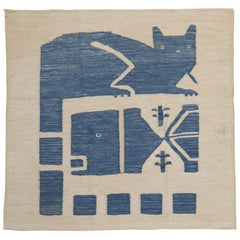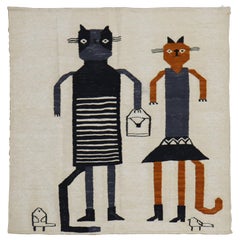Kitten Fish Primitive
20th Century Persian Organic Modern Persian Rugs
Wool
People Also Browsed
20th Century Persian Folk Art Persian Rugs
Wool
A Close Look at organic-modern Furniture
Organic modern furniture is characterized by clean lines, an overall uncomplicated aesthetic and a prioritizing of natural, sustainable materials, such as wood and stone. There are lots of earth tones and natural-world textures rather than bright color palettes or fabrics embellished with busy patterns.
Organic furniture is minimalist and, owing to the ideas of venerable architect Frank Lloyd Wright, designed for warm spaces that promote harmony between human habitation and the great outdoors. Organic modern design, including in furniture and architecture, emerged in the 1930s.
Designers such as Andrianna Shamaris, Alguacil & Perkoff and Jörg Pietschmann — all known for organic modern design — have created furniture that brings dynamic and unpredictable energy to home interiors while emphasizing the importance of a relationship with the natural world.
Striking an appealing balance between our living spaces and nature doesn't have to be an arduous task — the broad selection of original organic modern furniture on 1stDibs includes solid wood tables, bamboo seating options, hand-knotted wall tapestries and more.
Finding the Right persian-rugs for You
Make a bold statement in a living room or bedroom by incorporating vintage Persian rugs in your home decor.
A Persian carpet lends an aura of prestige to any room, even today. The fascination with Persian rugs dates at least as far back as the 4th century B.C., when historian Xenophon referred to the “soft rugs on which the Persians sit.” For centuries, Iran (modern-day Persia) has been known for the craftsmanship, intricate patterns and artistry of its carpets, which have found their way into households and museums around the world.
Although they have many imitators, real Persian rugs are made only in Iran and are easily recognized by their vibrant colors and elegant patterns.
Traditional, or antique, Persian rugs are what most people identify as “authentic.” Hand-made, they are very durable and, if properly cared for, can be passed down from generation to generation. Modern Persians, on the other hand, are often machine-made. Today’s carpets, Iranian or otherwise, can’t possibly match the level of craftsmanship that prevailed centuries ago, so historical Persian carpets will always be admired and highly valued.
Although the machine-aided production process is much faster and cheaper, the resulting rugs typically do not have the same quality or lifespan as handwoven ones, so traditional options are considered better investments.
To distinguish between the two, look for imperfections. Because traditional Persian rugs are handwoven, you will likely see small flaws on the front and back. With a machine-made imitation, on the other hand, you will probably not find stitching glitches, and the back will have a mesh or plastic covering.
Antique rugs are handmade from the finest materials, including wool, silk or cotton — never synthetic fibers. The fibers used in antique rugs are colored using natural dyes derived from insects and plants and woven into bold designs that reflect Iran’s culture and history. Since Persian tribes traditionally raised and herded sheep, wool was the most common material. The fiber has many advantages: It is fire-resistant and dries much more quickly than cotton. Also, because of its natural elasticity, it is more durable than cotton or silk. Regarded as works of art, Persian rugs can take months or years to complete.
The different types of Persian rugs are named for the cities, villages and regions where they’re made. Kashan rugs, for example, woven in the north-central Iranian city of Kashan, are considered among the finest city rugs, distinguished by curvilinear motifs like palmettos, leaves and arabesques. Nains have high knot counts, an indication of high quality, and generally employ pink, blue and ivory hues, while Tabriz rugs — created by weavers in the northwestern Iranian city of Tabrīz (or Tabriz) — mostly have floral and garden patterns.
When shopping for vintage Persian rugs, you'll want to consider color, size and more — for a history of these rugs and tips on how to style yours, visit our guide to these woven creations today.
Find Tabriz rugs, handmade silk Persian rugs, Persian tribal rugs and other antique and vintage rugs from the world's best furniture dealers on 1stDibs.

